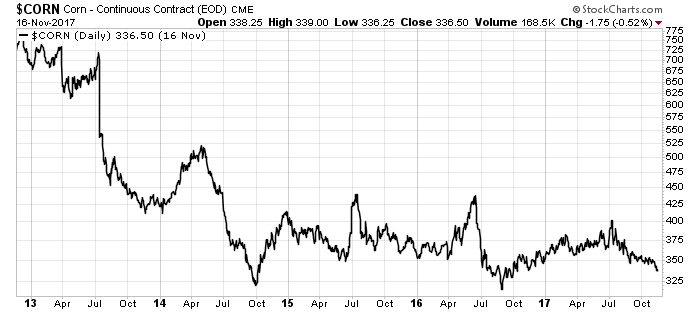All prices are set by how investors feel. Buying and selling shares or futures is an inherently inexact thing. Whether you are using supply/demand data or just a gut feeling, buying shares is a bet on what will happen in the future.
That’s why sentiment indicators are useful … but only in the extremes. When sentiment gets too high, it indicates a bad time to buy. When sentiment gets too low, it tells us that it’s a good time to buy.
For example, back in late 2008 to early 2009, sentiment toward stocks was terrible. No one wanted to buy stocks. Everyone was terrified to the extreme.
But if you bought the S&P 500 back then, when it was under 800 points, you would be sitting on 300% gains today.
That’s the way sentiment indicators work. They let us know when the greed or fear levels are too high.
Right now, the fear level in corn is the highest it’s been in four years. That means it’s probably a good time to speculate on corn.
Corn: A Hated Crop
The market hates corn right now.
According to the investment sentiment website sentimenTrader.com, corn is at its lowest point since November 2013. When sentiment got this low back then, the price of corn soared 22% in six months.
You can see the rally, and the present price, in the chart below:

While the corn price isn’t at a record low, it’s the sentiment extreme that lets us know it could be time to buy.
The problem is a record harvest. U.S. farmers got a surprise: The harvest looks like it will come in at a record 175.4 bushels per acre.
That is more than three bushels per acre higher than the October 2017 estimate. That’s 300 million extra bushels produced.
There will be more exports too — roughly 150 million bushels more consumed. However, the “carryover” (bushels that will stay in storage) will hit 150 million bushels. That’s a huge amount of grain in storage.
A Good Place for Speculation
The heavy crop surprised the market. It pushed the price down, when many farmers expected it to rise. Many farmers that hadn’t sold their crops yet, expecting November to bring in higher prices.
The crop news forced them to sell at lower prices. Many took what they could get, which pushed the corn price down further.
That’s why our sentiment indicator hit such an extreme. That’s called capitulation — when folks sitting on the sidelines just quit in disgust. It usually marks the low point in the market.
That also marks a good place for speculation.
The easiest way to do that is with the Teucrium Corn ETF (NYSE: CORN). The exchange-traded fund uses futures contracts to try to match the future price of the commodity.
The price may fluctuate a little bit in the next few weeks. However, I expect it to rise through the end of the year and into 2018.
Good investing,

Matt Badiali
Editor, Real Wealth Strategist









